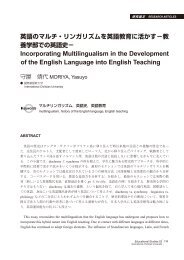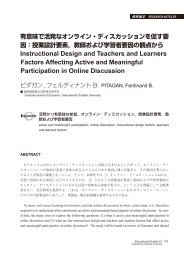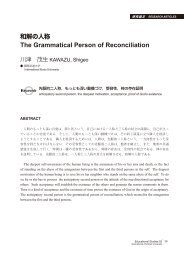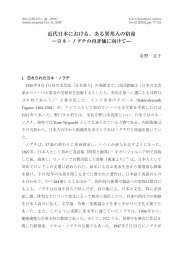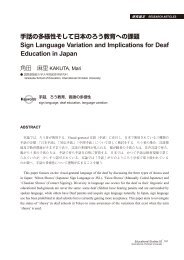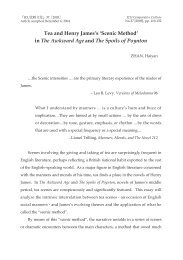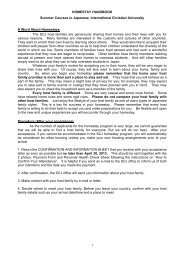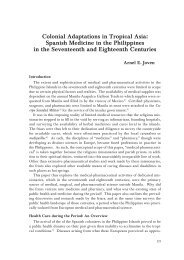Untitled - subsite - å½éåºç£æ大å¦
Untitled - subsite - å½éåºç£æ大å¦
Untitled - subsite - å½éåºç£æ大å¦
You also want an ePaper? Increase the reach of your titles
YUMPU automatically turns print PDFs into web optimized ePapers that Google loves.
: : 13<br />
Research Articles:Representing Sex and Sexuality: Requiem for Mother<br />
The close cultural association between women and food inspires the creative<br />
imagination of many male filmmakers in depicting complicated power relations<br />
between the sexes. In food films made by male directors, the heroine often underpins<br />
adult sexuality with her extraordinary cooking skills, similar to a mother forming a love<br />
relationship with her child at the early oedipal oral stage. For example, in a Mexican<br />
magic realism film, Water for Chocolate (Alfonso Arun, 1996), a Vietnamese film, The<br />
Scent of Green Papaya (Anh Hung Tran, 1994), and recent French films, Chocolat (Lasse<br />
Hasslastrom, 2001) and Amelie (Jean-Pierre Jeunet, 2002), the heroines enchant the<br />
world, which is full of misery, violence, hate or indifference among people, with the<br />
magic of food. Food in Ang Lees films, The Wedding Banquet (1993) and Eat Drink Man<br />
Woman (1994), reveals unmentionable, underlying conflicts between parents and<br />
children and attempts to resolve them in a mutually acceptable manner.<br />
On the other hand, male filmmakers representations of the female body always<br />
remain at the centre of feminist criticism. (Laura Mulvey, 1975; Claire Johnston, 1976;<br />
Rey Chow 1995; Maggie Humm 1997). For example, Doane argues that [c]inematic<br />
images of women have been so consistently oppressive and repressive and the filming<br />
of the female body constructs and maintains a hierarchy along the lines of a sexual<br />
difference assumed natural (1988: 216 and 217). However, the conflicts between the<br />
filmmaking practices and feminist concerns are not only problems in the cinematic<br />
representations of female bodies by male directors. On the contrary, as Sarah Sceats<br />
argues, contemporary women writers use of food in representing womens images is<br />
also problematic. According to Sceats, contemporary women writers tend to depict<br />
the fact that as anyone who has cooked for a family will know, nurturing may be<br />
experienced rather as an enslavement than as a power (1996: 118).<br />
Indeed, men substituted as food providers for families, such as the father in Eat Drink<br />
Man Woman or the sons American, gay partner in The Wedding Banquet, still discuss the<br />
significance of a mothering role in family relations. Despite the twisted representations<br />
of power relations within families, the food giving and receiving relationships confirm<br />
the cross-cultural significance of motherhood. Feeding, cooking, feasting and starving<br />
cannot be easily recognised in the absence of the notion of motherhood. In this<br />
sense, the provision of food can be problematic equally for women and men authors<br />
or directors. Neither women nor men can be easily freed from the prevailing cultural



